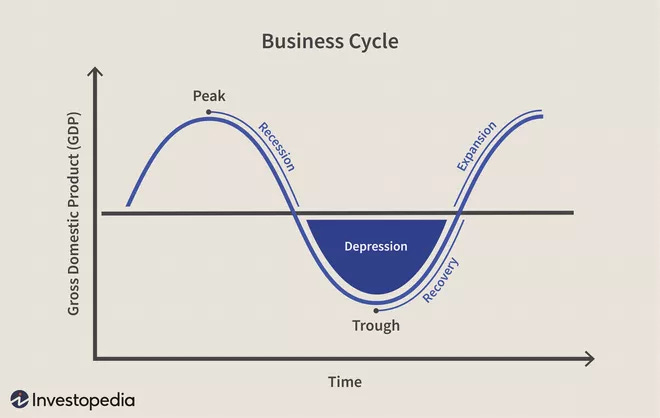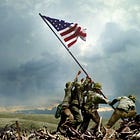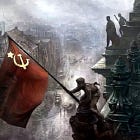4 | THE WHEEL OF HISTORY : Of Civil & Rival
Method & Madness | Book III : The Masters' Game

Order is not that which bounds Chaos—instead, just simply what’s found at its boundary. Chaos is not the absence of Order, for Order is itself the liminal ripple in a timeless flow of entropy.
—M. Hise
Since time immemorial, the human being has observed on this earth a perpetual cycle of growth and decay. Seasons pass, solstice to solstice—summer to winter; autumn to spring. War and peace—death, and rebirth. To us, it has always been obvious and apparent that—since long before we first walked this land—the soles of mortals trace only and always the shallow edge of an infinite circle.1
To ancient Sinitic cultures, this primordial force of cyclical time was called the Mandate of Heaven. In our today, we know it by the name of the Dynastic Cycle. Mystified in the West as religious superstition, the Dynastic Cycle is—in reality—a classical political theory which describes the cyclical course of Chinese civilization. To the perceptive student, it should appear immediately obvious that Chinese history actually does travel a roughly stable curve; a cyclical trajectory of growth and decay—
Of Survival & Prosperity.
In reality, this Dynastic Cycle is nothing mystical; it exists, instead, as simply a function of the shape of the board on which we play our Game. The centralization of a physical geography creates bias toward the centralization also of its society; thus is it easy for the Masters of China to (re)establish Civility through extant Civic homogeneity.2
Politics is driven by Social incentive. Society is driven by Economic incentive.
Thus can it be said that the movement of all theoretically distinct spheres of human theory are actually, in reality, unitarily motivated—driven by the Economy of Agency.3
Today, when we think of cyclicality—of concepts of return, and of growth-and-decay—we think no longer of the old cycles: of seasons or dynasties, or war and peace—even of life and death. These old cycles rest dim in our minds; no longer stood viscerally at the forefront of reality, but now instead oddities which seem to come aimlessly, meandering in from time-to-time—striking, perhaps, almost at random. In our today, we think of new cycles; macroeconomics—the Business Cycle: an oscillating system of Agentic output which drives the movement of politics, and the divination of which appears to define the future path of our Society; our world.
And so should it be apparent-and-obvious to those who know well their history4 that these Cycles—whether of Business or Dynasty—both describe the same phenomenon: an economic, Historical Cycle of growth and decay, expressed as [ Resources ÷ Time ].
Human beings need these things:
Water: to drink
Food: to eat
Shelter: to fend off the elements
These are Resources—and, all creatures know their necessity: that one must always acquire more Resources in order to benefit one’s Survival & Prosperity.
To collect Resources is to create Value-growth—supply, which must exceed demand. When supply fails to meet demand (whether by failure-of-competence or the great-forces of history5), then the Prosperity of Civility will begin to degrade. Given time—i.e. sufficient Value-decline—the systems of civilization will fail, returning its people to Rivality; reducing them to little more than a mass of hungry, desperate demand.
To Nietzsche, these twin World-states are the Apollonian and Dionysian:
Apollo: the god of art, light, and things-refined—Order: the patron of Civility.
Dionysos: the god of sex, drugs, and partying6—Chaos: the master of Rivality.
Where the Apollonian represents the heights of Social-Order, the Dionysian represents the breadth of primordial-Chaos.7 This distribution, however—though useful as a binary framework—is in practice somewhat lacking, as it discounts its logical consequences in favor of simplicity. The existence of Social order, after all, implies also the existence of Social chaos—and primordial Chaos implies, in turn, also primordial Order. Chaos, after all, is not always primordial; Order, after all, not always Man-made.8
Thus are there the primordial World-states: Order & Chaos.9 Then, there are the Social world-states:
Civility: the world of Social-order—of peace and Prosperity.10
Rivality: the world of Social-chaos—of violence and Survival.11
The goal of the Masters’ Game is to achieve Dominion; to cleave from basal Chaos and the Rival a place of order—of Civility. For the Adept, who holds faith in his Power, the plan is simple: conquer & create. For the Charlatan, who sees himself as weaker, the plan is single: appropriation.

The Adept12 is thus the architect of the rise of Civility—the Charlatan13, the harbinger of a return to Rivality.
The Adept chooses to raise his wall in order to build his Eden; to achieve Dominion through the exclusion of Chaos (and the Rival) in order to create Civility. In-so-doing does he initiate an era of Value-growth—of Prosperity—drawing a literal line between the worlds of Apollo and Dionysos.
The Charlatan desires to seize Dominion, and so chooses to inject Rivality in order to weaken the Civil-world, sowing division to depose the Master—but only just enough. And so is the Charlatan’s Gambit the most dangerous of games to play, for too much Rivality could destroy his prize and return the world to Dionysos—and a Chaotic world is, in the first place, a place in which the Charlatan had always struggled to thrive.

Through cunning tactics, he attempts to restructure the very morality of Civility. Because he lacks the Power to Survive—the skill and mastery to achieve Masterhood by legitimate means—he instead employs alternative methodology: the use of Ressentiment to convince his society to Value him Absolutely. He persuades the Complacent that because the Adept’s Civility can offer no Absolute guarantees, it is therefore inferior—that is, to his Civility, which he claims can offer Absolute Prosperity.
And so, to play the Charlatan’s Gambit is to attempt to flatten the Cube; to completely remake the architecture of the philosophy of his society.
If he succeeds—that is, in pressing Society (z) into line with the Axis of World-state (y)—then he will be able to obfuscate the idea of Social-Objectivity, confusing and diffusing it instead into the idea of Absolute-Objectivity.
In this way is he able to manufacture the Charlatan’s Box: a false world of two-dimensional philosophy—of smoke-and-mirror-morality, in which his fiction reigns supreme.
In this new Charlatan’s-world, there remains only one Objectivity: the Absolute—his Absolute—which stands superordinate to any Social knowledge. With Civility thus-enslaved to theory-from-before, the Value of our old songs and legends—the wisdom of our ancestors, and our close-held stories—fall pale against the blinding glare of the Charlatan’s claim to omniscient Truth.
In this Charlatan’s Box, there are not three, but two modes of existence:
Subjectivity: the world of perceived truths—things which you believe to be the case.
Objectivity: the world of brute facts—things which simply are the case.
Thus are there instead two axes—Power (x) and Nature (y)—and four types of people:
By playing his Gambit, the Charlatan unwittingly initiates an era of repression and decline. By superimposing his fiction—his reality14—upon the Civil-world, his obfuscation of truth impairs the ability of Civility to contend with the problems of Dionysian Facticity15. Because he is weaker, he culls the strong, raising petty fools to places of Power and suppressing the skilled and able, thus-ensuring that he himself is able to remain the strongest. So does he sow the seeds of conflict—of coming Rivalization—amongst his own people, tearing stones from the Master’s wall in order to build new barricades. He redraws the line between Civil and Rival—between permissible and forbidden; not however to protect his people, but instead to divide and control them. And so begins Value-decline, and a return to the Rivality of a world of Survival.
The Adept is born in the world of Dionysos—the Charlatan, in the world of Apollo.
The Adept aspires thus toward Apollo; toward truth, logic, light, and Ideal—to raise and achieve a perfect world: a creation in which all things move and live by his Method of immaculate design.
The Charlatan craves a return to Dionysos; toward fiction, Absurdity, and the imperfect-and-Real—the world of Madness above and beyond the laws of Man and mankind. Here, he believes, he may be able to find a greater liberation of himself, not realizing that even should he return to a primordial world… he would find himself still in a position weaker.
Each aspires toward his opposite—Real or Ideal—yearning to break away from his nature; to grasp the freedom which he feels that he was born… denied.
The Adept, who strives to win his Agency from arbitrary Chaos and violent Rivality, and;
The Charlatan, who seeks to reclaim his Power from the meticulous Dominion of Civility.
Thus is it apparent that the Historical Cycle—that is, growth-and-decline—is driven by the interchange between Charlatan and Adept; by the attitude held by the given Master who commands the Power to chart the course of Civility.
In the pre-modern world, we saw time as a cycle—in migrations, the seasons, and the tide. When we invented the cotton gin16, we threw our circles away. There was, after all, no cycle to be found on the factory floor but the turning of gears day-after-day. We came then to believe that time was linear—that the world moved on a line called progress; that we, as humans, had a duty to press forward, and never to move back again.
Today, we see the world’s technology progressing at a rapid rate—Resource-extraction and Value-accrual accelerating as the singularity17 looms. Many still believe human-time to be linear, but we few see and understand that, in reality: [ Value = Resources ÷ Time = Agency ] wherein Agency is exponential.
Time, to mankind, has never been circle or line. Instead, it has always been a cycling exponentiality: a curve which oscillates ever-closer to asymptotic singularity.
e.g. The Ouroboros, Ragnarök, the Osiris Cycle, the Four Periods (Zoroastrian), the Wheel of Dharma, the Five-Suns (Aztec), Spengler’s Civilizations (Modern, German), etc.
This is obviously not to say that Chinese civilization never collapses—simply that, when it does collapse, it’s relatively easy for a new Master to reunite its society because of its geography. The opposite effect is seen in the Balkans—the premier example of how geographic barriers create division, and therefore disparate and discrete socio-cultural identity.
Book III, Section 2: The Bondsman’s Prayer. Economics is the study of the behavior of human societies—how they create, move, and distribute things-of-Value. Value is the things which human beings trade their lives to acquire, experience, or create—thus, what we find to be of Value… is singly what we live our lives for.
That is, the perpetual students of history, economics, and geopolitical theory.
i.e. War, famine, natural disasters, etc.
The god of primal nature: fertility (i.e. fucking), plants (from which all contemporary mind-altering substances were made), the festival, and “ritual madness, insanity, & ecstasy” (e.g. a rave, or a heavy-metal mosh-pit).
In a Freudian context, one might think of Dionysos as collective id and Apollo as collective superego. Alternatively, as Method & Madness.
Order is not that which bounds Chaos—instead, just simply what’s found at its boundary. Chaos is not the absence of Order, for Order is itself the liminal ripple in a timeless flow of entropy. e.g. Fractals (shorelines, tree branches), evolution (natural selection), cosmology (galactic formation). Just as heat is not the absence of “cold”, but instead a spectrum which runs high-heat to no-, Chaos is not the absence of Order—instead Order is itself no-Chaos.
As in Book II, Section 9: The Dialectical Cube.
Where Civil [Adj.] describes a state of personal Social-belonging, Civility [N.] represents the Civil-world: a Social world which is ordered—that is, comprised of individual Civil-people—and supports a culture of stability conducive to peace and Prosperity (i.e. a high-trust society).
Where Rival [Adj.] describes a state of personal Social-alienation, Rivality [N.] represents the Rival-world: a Social world which is chaotic—that is, comprised of a variable mix of Civil- and Rival-people—and fosters a culture of volatility favoring violence and Survival (i.e. a low-trust society).
Book III, Section 1: The Adept’s Gambit.
Book III, Section 3: The Charlatan’s Gambit.
Book I, Section 3: Method & Madness.
That is, the real world: the world beyond the walls of Eden.
1793. A hallmark of the beginning of the Industrial Revolution—i.e. the first instance of the creation of Capital (i.e. the means of production), and thus of Capitalism-in-praxis.
The convergence of all technologies necessary to create and power Artificial General Intelligence (AGI); the inflection point beyond which functionally infinite energy—that is, infinite Agency, and therefore infinite Value—may be achieved.
























